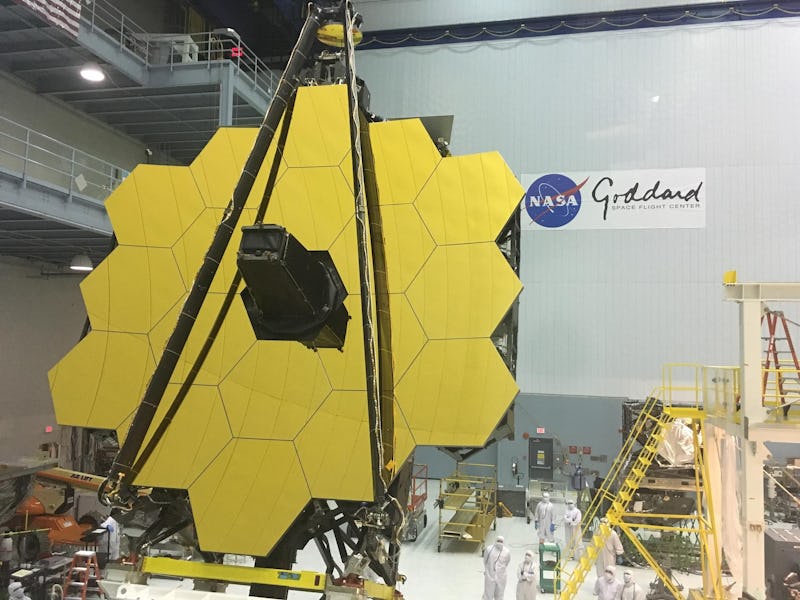NASA discovers Webb has enough fuel for a decade-plus of deep space observations
NASA announced Wednesday that James Webb telescope course corrections used less fuel than expected, which means Webb can expect to work for more than 10 years

After years of development, delays, hope, and anxiety, the James Webb Space Telescope is finally in space and speeding on its way to a point 1 million miles from Earth from where it can peer deeper into the universe than any telescope before it.
And as NASA announced Wednesday morning, Webb may get to peer deep into the universe for even longer than expected: Webb used less of its limited supply of propellant during two course-correction thruster burns after launch than expected, and the space agency says it should have enough left over to enable operations “significantly” longer than the expected 10-year mission.
That’s particularly important for Webb, which will operate too far from Earth to be serviced or refueled like the aging Hubble telescope. If all continues to go well with Webb’s deployment and testing over the coming months, today’s fuel savings will mean several tomorrows’ stunning images of the most distant galaxies in our universe.
What’s new with Webb?— According to a NASA blog post, Webb’s fuel savings are due to a very precise launch atop an ESA Ariane 5 rocket on Christmas Day.
NASA purposefully sent Webb at a slightly lower velocity than needed to reach its target, Lagrangian point 2 (L2), to avoid overshooting its mark. Two course-correction burns were planned to make up the necessary difference, but that difference turns out to be smaller than expected, thus saving Webb some gas for later.
And it will need that propellant for later. A third course-correction burn near the end of January will insert Webb in orbit at L2, a region where Earth and the Sun’s gravity cancel out, allowing the Webb to keep Earth at its back as our planet and our space telescope orbit the Sun.
An ESA illustration of the Webb telescope’s orbit around Lagrangian Point 2.
While doing science at L2, Webb will need additional fuel to maintain its orbit around L2 over the years to come, as well as to adjust its orientation in space during its observations of the cosmos.
NASA designed Webb to operate for a minimum of five years in deep space, but mission scientists have always hoped it would operate for 10 or more years, given the time and resources devoted to making the space telescope a reality. Now it looks like they just might get those extra years of observation time.
How does Webb compare with Hubble?
Although it’s not technically the successor to the Hubble Space Telescope, Webb is often compared to the well-known Hubble observatory, which is now in its 31st year in orbit.
NASA launched Hubble in 1990, and its long operational life is due to its design, meant to be serviceable by astronauts using the now-retired Space Shuttle. Astronauts corrected flaws in Hubble’s primary mirror in the first servicing mission in 1993, and additional upgrades and repairs were made over the years, concluding with the final service mission in 2009.
Orbiting at L2, Webb will not enjoy Hubble's safety net. There are no spacecraft currently capable of reaching Webb at L2 to fix problems or refuel the space telescope, which is why NASA spent so many years designing and testing Webb to ensure it could survive for a long time alone, in the dark.
What will Webb do during its 10-plus years in space?
Webb’s mission is to explore the universe in the infrared spectrum, the perfect wavelengths of light for viewing the most distant — and therefore earliest — parts of the universe. Webb will hunt for the faintest galaxies from just after the birth of our universe, acting as both a telescope and, in a sense, a time machine.
But astronomers will also use Webb to observe how stars and planets form, peer into the supermassive black hole at the center of our galaxy, measure the chemical properties of exoplanets, and even observe planets within our own Solar System.
What’s next for Webb?— As of Wednesday afternoon, Webb was around 360,000 miles from Earth, with just less than 540,000 miles to go to reach L2.
Webb has plenty to do during the trip, including its task for the next several days to a week: Unfolding and deploying its tennis court-sized sunshield that will shade its sensitive infrared instruments from the heat of both Sun and Earth. At the moment, Webb’s “hot” side is measuring around 49 degrees Fahrenheit, according to NASA, while its cold side is already down to minus 244 degrees. It will have to cool to minus 388 degrees Fahrenheit before it can do any science.
Webb will begin unfolding and deploying its primary and secondary mirrors, testing mirror segments, and preparing for orbital insertion at L2 in the coming weeks. You can follow along with NASA Goddard Space Flight Center’s “Where’s Webb” website.